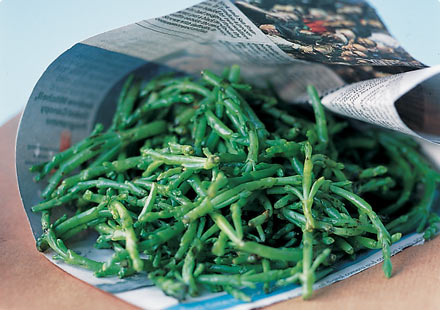Since childhood we have eagerly awaited the time in early summer when Samphire would start to be brought in by the local fisherman on the Norfolk coast.
Samphire is a sea vegetable that grows abundantly on shorelines, in marshy shallows and on salty mudflats. It has a crisp texture and tastes of the sea. The seasons starts around June and ends in September but I always find the best samphire is harvested in July.
North Norfolk boasts the largest expanse of salt marsh in the country and with it, Britain’s best supply of samphire. The villages surrounding Anna’s House at Thornham such as Brancaster and the Burnham’s have for hundreds of years foraged the crisp sea vegetable from the mud to sell outside their houses or eat with seafood and butter. Pronounced “sam-fur,” rather than the phonetic “sam-fire” heard outside the region. The name samphire is a corruption of “Saint Pierre” – St. Peter – the patron saint of fishermen.
Samphire was also a traditional source of sodium in glassmaking and soap manufacture. The latter use gave it its alternative name, ‘glasswort’. A 16th-century resurgence in English glassmaking, which had suffered a long decline after Roman times was led by glassmakers who emigrated to England from Lorraine and Venice. The Lorraine glassmakers brought with them the technology of the greenish glass that used potash from wood ashes as a flux. The Venetian glassmakers brought with them the technology of cristallo, the immaculately clear glass that used soda ash as a flux. Samphire was dried and then burnt in heaps as part of the manufacturing process.
The proper name for Samphire is edible Salicornia Europea. It has a nautical heritage and Samphire was pickled for taking on long sea journeys and viewed as a useful herb to prevent scurvy. Often referred to as the ‘poor man’s asparagus’ samphire is now sold in the coasts’ local shops, markets and at fisherman’s stalls during the summer season.

Norfolk samphire is a far-cry from the expensive dish popular in posh London restaurants and sometimes on sale in supermarkets, where it is often flown in from Israel or Mexico.
Top London chefs consider samphire quite a delicacy and serve tiny portions of it as a starter or as an accompaniment to meat and fish. They barely show it any boiling water and as a result it’s crisp and hard to digest. Norfolk locals have different ideas. If you want to enjoy it the Norfolk way , you’ll boil it for 5-15 minutes until it comes off its stalk with ease and eat it like ‘sea asparagus’. Load your plate high and tuck into it with lots of hot melted butter and pepper (no salt!). Others local’s insist only vinegar is required and some fresh bread and butter. In its purest form it’s simply divine.
Friends travelling from afar to stay for a summer weekend in Norfolk often ring a few days ahead. ‘I don’t suppose you’ll be cooking any of that Norfolk seaweed – What’s it called?’

Many of the local restaurants will be serving up Samphire in some form or other from the early summer. Alternatively, pop up to Gurneys fishmonger just up the road from Anna’s House and pick up a generous bunch to take home and remind you of the Norfolk Coast.
Useful Information
There are quite a few Samphire recipes out there that will not have great results when cooking Norfolk marsh Samphire. Here is a simple and no-nonsense method to cooking delicious samphire. Go here for How to really cook Samphire

